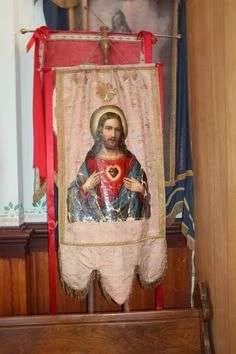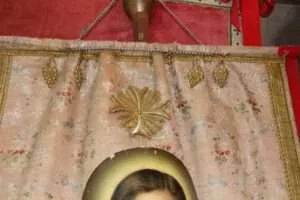St. Ignatius Mission Banners
St. Ignatius Mission Banners
St. Ignatius Mission Banners: Church banners come in many shapes, sizes, colors, and designs. In days gone by, church banners were rendered in detailed and elaborate Ecclesiastical Embroidery designs such as the Great Processional Banner at York Minster, which makes them works of art in themselves. When looking through books that document the history of Ecclesiastical Sewing, the lavish use of hand embroidery on banners was quite common. Church banners received the same care and attention as did altar frontals and Church Vestments such as stoles, copes, and chasubles. In the book Church Embroidery and Church Vestments by Lucy Vaughn Hayden Mackrille, she discusses the hand embroidery work done on several large church banners for the Washington Cathedral.
The banner being discussed by Miss Mackrille in the above image is a large banner, 27″ wide by 36″ long, and every member of the Washington Cathedral Altar Guild had a part in its making.
One gains an understanding of the work involved in creating these Church banners by reading Miss Mackrille’s description of the process:
“All around the edge of this is an embroidered border of the Glastonbury thorn. The verse chosen for the banner is from St. Mark, 11:17, which voices the purpose and aspiration of the Cathedral. The capital letters are adorned and illuminated with countless scrolls in gold thread, with many jewels; and the spaces between the words and on each side of them are filled with many lovely bits of gold work and embroidered leaves and scrolls. The center panel is framed in heavy cream color grosgrain silk, ornamented with a red border. The letter “W” down in the corner, set in a shield, is for Washington. Love and devotion were poured into the making of this banner.
The reverse side is scarlet grosgrain silk on which is set a large Jerusalem cross made of white broadcloth, in the center of which are the keys of St. Peter. and the sword of St. Paul……. ” (Mackrille, 1939, p. 78)
Embroidery, a perfect medium for use on banners, becomes a true labor of love, provided skilled embroiderers are available for the required work. But sadly, there were times when this level of devotion may not have been possible for a banner. When embroidery was not an option, banners were sometimes hand-painted like these Banners located at the Ursuline Center. The banners found at the Ursuline Center last summer were a surprise! They were found in an artist studio of all places.
Painted banners are usually a surprise when I stumble across them. They are so unexpected. And now, once again, this summer, in a small church, painted banners surface yet again.

St. Ignatius Banner Design
This is one of three banners on view at the St. Ignatius Mission. This hand-painted image shows Christ with the Sacred Heart symbol. The eyes of Christ are striking on this painted banner. They seem to have a kindly disposition and are so forgiving. The paint is heavy, and with age and use, it is cracked and worn.
On seeing the banner, a host of questions abound: who painted the banner? Was it ordered from a vestment house; did someone paint the fabric, and have someone else finish making the banner? Could someone from the mission have painted the banner? Was it the cook? Sadly, there were no clues to be found to unravel the mystery. Our time at the church was very limited, and with the heat in the church, we did not have time to study the painting on the banner or note whether it matched the style of the mural paintings by Brother Joseph Carignano. One can only wonder. If an untrained cook painted the beautiful wall murals, he would certainly be brave enough to try his hand at painting a church banner. Perhaps on another trip…. we can take a closer look.
Discoveries on the St. Ignatius Banner
The painting was not the only surprise to be noted on the St. Ignatius banner. A few additional surprises were waiting in the wings to be discovered. Upon closer inspection, the banners revealed more unexpected techniques. In addition to the painting, this banner has a touch of goldwork embroidery.

At the top edge of the banner, there are four grape clusters and a goldwork cross. The banner edges are finished with gold galloon trim, and gold bullion fringe finishes the scalloped edges on the bottom of the banner. Gold bullion, although frequently visible on vestments at the turn of the previous century, had to be costly in its day. The price of gold bullion today makes the trim almost untouchable.
It is difficult to know whether this banner is still in use today. But since it was located at the back of the church, and out for display, one must assume it is still in use.
Church Banners
Church banners have a long tradition of use within the church. They often made them from the same materials as other vestments and hangings within the church, with the same level of care and devotion. Maybe churches today might take a lesson from the past when considering the making of new banners. While banners do not necessarily require hand embroidery, people should make them with the same level of devotion and care given to other items used within the church.
Solo Dei Gloria
Be sure to visit our online store front Ecclesiastical Sewing where you may shop for Liturgical Fabrics, altar linen fabrics, church vestment-making patterns, liturgical machine embroidery designs, church vestment trims and notions and so much more. You may also find us on Ecclesiastical Sewing on Facebook, Twitter, and Pinterest. Sign up for our mailing list at the bottom of the page on our online store front and receive a free copy of our Small Linens Booklet as our way of saying thank you for following along.
References:
Mackrille, L. (1939) Church Embroidery and Church Vestments. Baltimore: The Monumental Printing Company
Bespoke Vestments and Paraments
White Liturgical Religious Fabrics for Making Church Vestments
New Rose Pastoral Chasuble and Stole






 RSS - Posts
RSS - Posts
You must be logged in to post a comment.